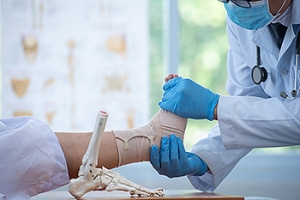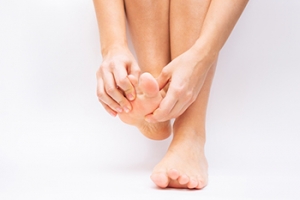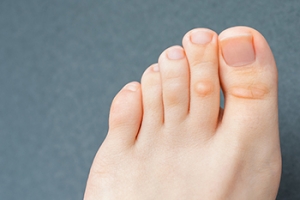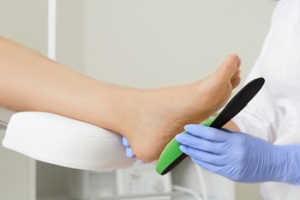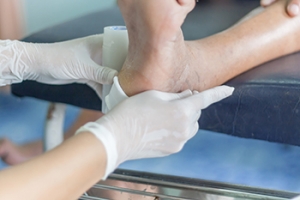Super User
Benefits of Foot Therapy
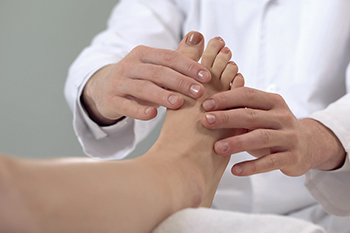 Foot therapy can be a relaxing and rewarding experience. It falls into two categories consisting of foot massages and reflexology. The latter is done by stimulating the energy channels in the body by touching the feet in specific areas. There are parts of the foot that are connected to various organs and bones and can interact with the tissues in the feet. When a foot massage is given, it is generally more direct and may be helpful in relieving tight muscles. Additionally, circulation may be improved, and existing soreness may be reduced. Many people enjoy having reflexology performed on them as it can bring positive feelings to the overall body. The digestive system may be improved in addition to having increased energy. If you would like to know more information about the benefits of foot therapy, please confer with a podiatrist .
Foot therapy can be a relaxing and rewarding experience. It falls into two categories consisting of foot massages and reflexology. The latter is done by stimulating the energy channels in the body by touching the feet in specific areas. There are parts of the foot that are connected to various organs and bones and can interact with the tissues in the feet. When a foot massage is given, it is generally more direct and may be helpful in relieving tight muscles. Additionally, circulation may be improved, and existing soreness may be reduced. Many people enjoy having reflexology performed on them as it can bring positive feelings to the overall body. The digestive system may be improved in addition to having increased energy. If you would like to know more information about the benefits of foot therapy, please confer with a podiatrist .
Foot therapy is often necessary for those recovering from either foot deformities or foot injuries. If you have concerns regarding therapy, consult with Dr. Thomas E. Silver from Westwood Foot Clinic. Our doctor can provide the care you need to keep you pain-free and on your feet.
Most Common Injuries
People who are active or athletes are prone to a variety of injuries. Therefore, it is often important to take part in physical therapy in order to quickly get back on the right track.
What to Do When Injured
Physical Therapy – This specialized treatment will focus on the affected area, speeding up recovery and the overall healing process. It is a proven method that has helped millions of people return from any injury.
During physical therapy you will undergo regimented training to get back into full form. Training is often very difficult, especially at first when the foot feels weak. Physical therapy often involves:
Basic stretching and twisting exercises – getting the feet’s mobility and flexibility up.
Massaging – the therapist will massage the injured area in order to activate the muscles and relax them.
Strengthening Exercises – this allows the muscles in the affected area to regain their full strength, a vital step towards full recovery.
If you have any questions please feel free to contact our office located in Golden Valley, MN . We offer the newest diagnostic tools and technology to treat your foot and ankle needs.
Foot Therapy for Sports Injuries
Foot Therapy for Sports Injuries
Athletes are used to engaging in high-intensity workouts. Consequently, athletes are at an increased risk for enduring foot or ankle injuries. The most common way to treat these types of injuries is the RICE method (Rest, Ice, Compression, and Elevation). However, braces and casts may be required in some cases. If you are suffering from any of these injuries, it is best that you seek help from your podiatrist right away.
Achilles Tendinitis
Achilles tendinitis is a type of overuse injury of the Achilles tendon, which is the tendon connecting the calf muscles to the heel. This type of injury commonly occurs in runners who increase the intensity of their workouts. Symptoms for this condition start off as a mild ache in the back leg or above the heel. Some people experience tenderness around the area in the morning, however this feeling tends to improve over time. If you suspect you have Achilles tendinitis, you doctor may order an x-ray to show whether your Achilles tendon has calcified. Common treatment options for this condition include rest, ice, exercise, and non-steroidal anti-inflammatory medication.
Plantar Fasciitis
Plantar Fasciitis is a condition that is commonly found in women. It is a painful condition that occurs when the bands of tissue that connect the heel to the toes become inflamed. Symptoms for plantar fasciitis are heel pain that worsens in the morning and improves throughout the day with activity. Your podiatrist will diagnose plantar fasciitis by checking for tender areas on your foot. In rare cases, an x-ray may be required for a more thorough examination. There are various treatment options that may be used to help someone with this ailment. Depending on the specific case, some of these options include: physical therapy, shockwave therapy, and in rare cases, surgery.
Stress Fractures
Stress fractures are tiny cracks in the bone that occur due to repetitive force. These fractures are typically the result of overuse injuries such as repeatedly running and jumping. Symptoms of a stress fracture include pain when exercising, tenderness, and mild swelling. To diagnose a stress fracture, your doctor will likely ask you a series of questions about your overall health and the activities you are involved in. Next, an x-ray will likely be performed to check for the fracture. In some cases, fractures don’t appear on x-rays until weeks afterward. In these cases, an MRI or a bone scan may be required. Typical stress fractures may be treated by resting the area and taking a break from highly intense activities.
Ankle Sprain
Ankle sprains occur when the ligaments that support the ankle are stretched far beyond their limits. These injuries occur when you roll, twist, or turn your ankle in an awkward way. Ligaments are essential in helping us move around because they are responsible for stabilizing the joints. Usually, sprained ankles occur due to ligaments on the outer part of the ankle becoming stretched. Symptoms of ankle sprains are swelling, bruising, instability of the ankle, and restricted range of motion. Normally, when people sprain their ankle, they will hear a popping sound during the injury. Depending on the severity, ankle sprains are graded based on how much damage has occurred to the ligaments. Grade 1 is mild, grade 2 is moderate, and grade 3 is severe.
A Broken Foot and a Sprained Ankle May Share the Same Symptoms
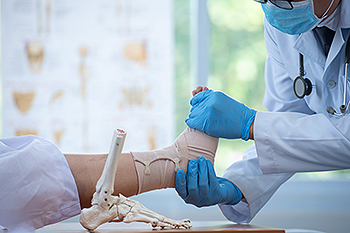
A broken foot often requires immediate medical attention. It generally causes severe pain and discomfort and can happen for a variety of reasons. These include a foot injury, twisting it well beyond its normal range of motion, or an accident. Symptoms include swelling, bruising, and difficulty bearing weight. If the foot is severely fractured, a bone may protrude from the skin, appearing to be displaced. A mildly broken foot may be confused with a sprain, because the two types of injuries share similar symptoms. Some patients hear a popping sound, which is often indicative of a broken foot, rather than a sprained ankle. A proper diagnosis can confirm a broken foot by having an X-ray taken. Treatment can begin by having a cast put on the affected foot, which is helpful in providing stability as the healing process occurs. Crutches are often recommended to use while the foot is in a cast, helping the patient to remain mobile. If you have broken your foot, please call a podiatrist’s office as quickly as possible for proper treatment techniques.
A broken foot requires immediate medical attention and treatment. If you need your feet checked, contact Dr. Thomas E. Silver from Westwood Foot Clinic. Our doctor can provide the care you need to keep you pain-free and on your feet.
Broken Foot Causes, Symptoms, and Treatment
A broken foot is caused by one of the bones in the foot typically breaking when bended, crushed, or stretched beyond its natural capabilities. Usually the location of the fracture indicates how the break occurred, whether it was through an object, fall, or any other type of injury.
Common Symptoms of Broken Feet:
- Bruising
- Pain
- Redness
- Swelling
- Blue in color
- Numbness
- Cold
- Misshapen
- Cuts
- Deformities
Those that suspect they have a broken foot shoot seek urgent medical attention where a medical professional could diagnose the severity.
Treatment for broken bones varies depending on the cause, severity and location. Some will require the use of splints, casts or crutches while others could even involve surgery to repair the broken bones. Personal care includes the use of ice and keeping the foot stabilized and elevated.
If you have any questions please feel free to contact our office located in Golden Valley, MN . We offer the newest diagnostic and treatment technologies for all your foot and ankle needs.
Causes of Toe Joint Pain
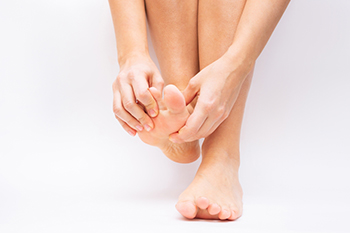
The most common form of toe pain occurs in the big toe. This joint takes a lot of abuse, as it absorbs most of the body weight with each step you take. The two main big toe complaints are gout and bunions. Less frequent causes are turf toe, and ingrown toenails. Toe pain to the smaller toes is most often caused by hammertoes and claw toes. Gout is an inflammatory disease that attacks the joints, causing redness, swelling and extreme pain. It is connected to a buildup of uric acid that crystalizes and induces pain. Bunions are a deformity at the base of the big toe, usually passed on genetically but made worse by ill-fitting footwear. It causes the toe to push outward at the base and inward at the top. It can adversely affect the biomechanics of the foot, causing other foot problems. Turf toe is common to football and basketball players, and dancers, who frequently push off the ground and hyper-extend their big toe. Ingrown toenails develop when the nail grows into the nailbed. Pressure from tight shoes can irritate the area, causing pain. Hammertoe and claw toe are painful deformities that affect the joints, tendons and soft tissues of the smaller toes. For help with any toe pain conditions you may be experiencing, it is suggested that you consult with a podiatrist.
Toe pain can disrupt your daily activities. If you have any concerns, contact Dr. Thomas E. Silver of Westwood Foot Clinic. Our doctor can provide the care you need to keep you pain-free and on your feet.
What Causes Toe Pain?
Most severe toe pain is caused due to a sports injury, trauma from dropping something heavy on the toe, or bumping into something rigid. Other problems can develop over time for various reasons.
Toe pain can be caused by one or more ailments. The most common include:
- Trauma
- Sports injury
- Wearing shoes that are too tight
- Arthritis
- Gout
- Corns and calluses
- Hammertoe
- Bunions
- Blisters
- Ingrown toenails
- Sprains
- Fractures (broken bones)
- Dislocations
When to See a Podiatrist
- Severe pain
- Persistent pain that lasts more than a week
- Signs of infection
- Continued swelling
- Pain that prevents walking
Diagnosis
In many cases the cause of toe pain is obvious, but in others, a podiatrist may want to use more advanced methods to determine the problem. These can range from simple visual inspections and sensation tests to X-rays and MRI scans. Prior medical history, family medical history, and any recent physical traumatic events will all be taken into consideration for a proper diagnosis.
Treatment
Treatments for toe pain and injuries vary and may include shoe inserts, padding, taping, medicines, injections, and in some cases, surgery. If you believe that you have broken a toe, please see a podiatrist as soon as possible.
If you have any questions please feel free to contact our office located in Golden Valley, MN . We offer the newest diagnostic tools and technology to treat your foot and ankle needs.
Complications of Corns
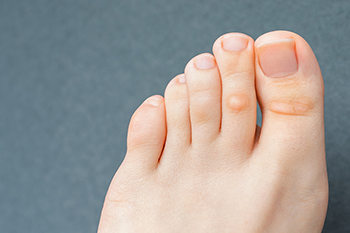
Corns are hardened spots of skin that can develop on the feet in response to pressure or friction. Specifically, corns develop on, near, and between the toes. Sometimes, corns can grow on an individual’s feet because their shoes are ill-fitting and too tight, causing the material to repeatedly rub up against the foot. This creates the kind of friction that causes corns. There are several complications associated with this particular foot affliction to be aware of. First, in severe cases of corns, the individual may experience a sensation of pain at the affected area. Having a particularly troublesome corn could also negatively impact your gait and capacity to walk or run. Severe cases of corns, if left unaddressed and untreated, might also lead to infections. Healthy tissues in and around the affected area on the foot could also be harmed or damaged by corns. If you have corns on your feet, contact a podiatrist and schedule an appointment today. This foot specialist can help you try to avoid these complications.
If you have any concerns regarding your feet and ankles, contact Dr. Thomas E. Silver of Westwood Foot Clinic. Our doctor will treat your foot and ankle needs.
Corns: What Are They? and How Do You Get Rid of Them?
Corns can be described as areas of the skin that have thickened to the point of becoming painful or irritating. They are often layers and layers of the skin that have become dry and rough, and are normally smaller than calluses.
Ways to Prevent Corns
There are many ways to get rid of painful corns such as wearing:
- Well-fitting socks
- Comfortable shoes that are not tight around your foot
- Shoes that offer support
Treating Corns
Treatment of corns involves removing the dead skin that has built up in the specific area of the foot. Consult with Our doctor to determine the best treatment option for your case of corns.
If you have any questions please feel free to contact our office located in Golden Valley, MN . We offer the newest diagnostic and treatment technologies for all your foot and ankle needs.
When to Consider Orthotics
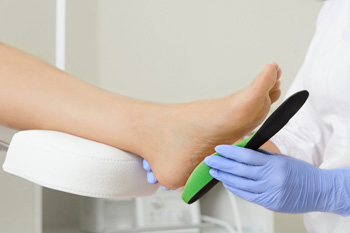 Orthotics are shoe or heel inserts that can help with a variety of foot, leg, and back problems. They can help the foot and ankle work better, correct foot deformities, and reduce risk for further injuries. Generic orthotics can be purchased online or in stores or they can be prescribed by a podiatrist and custom-made specifically for your needs. Orthotics have been used to deal with foot pain associated with arthritis, lack of foot cushioning, high arches, bunions, diabetic neuropathy, high arches, and other foot conditions. If you are experiencing foot or heel pain that is not relieved by over-the-counter treatments, exercises or rest, a podiatrist can examine the condition of your feet, watch you walk and perform movements, and possibly recommend imaging, such as an X-ray, bone scan, or MRI to identify specific problem areas and create custom orthotics and/or other avenues of treatment.
Orthotics are shoe or heel inserts that can help with a variety of foot, leg, and back problems. They can help the foot and ankle work better, correct foot deformities, and reduce risk for further injuries. Generic orthotics can be purchased online or in stores or they can be prescribed by a podiatrist and custom-made specifically for your needs. Orthotics have been used to deal with foot pain associated with arthritis, lack of foot cushioning, high arches, bunions, diabetic neuropathy, high arches, and other foot conditions. If you are experiencing foot or heel pain that is not relieved by over-the-counter treatments, exercises or rest, a podiatrist can examine the condition of your feet, watch you walk and perform movements, and possibly recommend imaging, such as an X-ray, bone scan, or MRI to identify specific problem areas and create custom orthotics and/or other avenues of treatment.
If you are having discomfort in your feet and would like to try orthotics, contact Dr. Thomas E. Silver from Westwood Foot Clinic. Our doctor can provide the care you need to keep you pain-free and on your feet.
What Are Orthotics?
Orthotics are inserts you can place into your shoes to help with a variety of foot problems such as flat feet or foot pain. Orthotics provide relief and comfort for minor foot and heel pain but can’t correct serious biomechanical problems in your feet.
Over-the-Counter Inserts
Orthotics come in a wide variety of over-the-counter inserts that are used to treat foot pain, heel pain, and minor problems. For example, arch supports can be inserted into your shoes to help correct overarched or flat feet, while gel insoles are often used because they provide comfort and relief from foot and heel pain by alleviating pressure.
Prescription Orthotics
If over-the-counter inserts don’t work for you or if you have a more severe foot concern, it is possible to have your podiatrist prescribe custom orthotics. These high-quality inserts are designed to treat problems such as abnormal motion, plantar fasciitis, and severe forms of heel pain. They can even be used to help patients suffering from diabetes by treating foot ulcers and painful calluses and are usually molded to your feet individually, which allows them to provide full support and comfort.
If you are experiencing minor to severe foot or heel pain, it’s recommended to speak with your podiatrist about the possibilities of using orthotics. A podiatrist can determine which type of orthotic is right for you and allow you to take the first steps towards being pain-free.
If you have any questions please contact our office located in Golden Valley, MN . We offer the newest diagnostic and treatment technologies for all your foot and ankle needs.
How to Find Shoes That Fit Perfectly
While great looking shoes might catch your eye, make sure they are as comfortable and properly fitted as they are attractive before you buy them. Have both feet measured every time you buy shoes to make sure they haven’t grown in length or width. Bring a tracing of your foot with you when you go shoe shopping. Any shoe you place on top of the tracing that is smaller in width or length should be avoided. Wear the same socks that you are planning on wearing with the new shoes. Make sure you shop in the afternoon, after your feet have expanded during the day. There should be approximately 1/2 inch of space between the end of the shoe and your longest toe when you are standing up in the shoes, and enough room to wiggle your toes comfortably. Make sure they don’t squeeze the ball of your feet and that they fit comfortably at the heel without pinching or slipping around. Any shoe you buy should fit correctly as you are trying them on, without having to “break them in.” If a larger or wider size feels more comfortable, buy that, rather than trying to squeeze into a size you believe should fit you. Check the inside of the shoe to make sure there aren’t any rough edges or seams that will rub against your foot, and walk around the store in them to make sure they fit snugly without being tight or slipping off. For more professional tips on buying shoes, as well as finding the right shoe for your particular foot, make an appointment with a podiatrist.
Getting the right shoe size is an important part of proper foot health. Seek the assistance of Dr. Thomas E. Silver from Westwood Foot Clinic. Our doctor will provide the care you need to keep you pain-free and on your feet.
Getting the Right Shoe Size
There are many people who wear shoes that are the incorrect size, negatively affecting their feet and posture. Selecting the right shoes is not a difficult process, so long as you keep several things in mind when it comes to choosing the right pair.
- When visiting the shoe store, use the tools available to measure your foot.
- Be sure there is ‘wiggle room’. There should be about an inch between your toes and the tip of your shoes.
- Do not always assume you are the same size, as manufacturers run differently.
- Purchase shoes later in the day, as your feet swell as the day progresses.
- If a shoe is not comfortable, it is not suitable. Most shoes can’t be ‘broken in’, and comfort should be the ultimate goal when it comes to choosing the right pair of shoes
As our feet hold our body weight and keep us moving, it is important to treat them right. Picking the right pair of shoes can provide your feet comfort and mobility without pain.
If you have any questions, please feel free to contact our office located in Golden Valley, MN . We offer the newest diagnostic and treatment technologies for all your foot care needs.
Getting the Right Shoe Size: To Keep Your Feet Happy
People are constantly wearing improperly-fitting shoes. Though it isn’t hard, picking the right shoes does require keeping a few things in mind.
Shoe stores have rulers so you can get an exact measurement of your feet. Be sure to always measure your feet with your shoes on. Measuring just your foot will give you a shoe size that is 1-2 inches too small for picking the right size shoe.
To ensure that your toes won’t be cramped, make sure there is wiggle room. Approximately one inch should be between your toes and the tip of your shoe. It is easy to tell if your shoes are too tight, because you will start to experience pain, blisters, and swelling.
Additionally, do not always assume your shoe size will be the same at every store. Manufacturers sometimes run differently, and your size will vary from brand to brand. Make sure the stores you purchase from have return policies, in case there is a problem.
Rather than shoe shopping in the morning, it is advised to shop for shoes later in the day. Your feet will swell as the day passes. If shoes are purchased in the morning, they may not be as snug as they should be. Furthermore, not all two feet are the same size. Therefore, accommodations may be necessary.
An overall concern in buying shoes is making sure they are comfortable and supportive. There is no such thing as a shoe being ‘broken in’. If they are uncomfortable at the store, they likely will always be uncomfortable.
Since we do a lot of walking, it is important that we pick the right shoes. Our feet will benefit from this, and we will be happier and healthier because of it.
How Plantar Fasciitis Is Treated
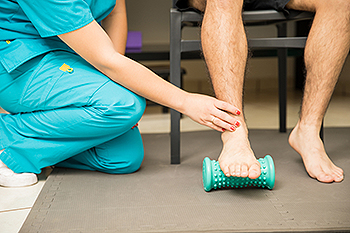
Plantar Fasciitis is a common foot ailment that causes pain in the heel of the foot. The facia, or band of tissue that connects the heel to the toes, becomes irritated and inflamed. This condition usually occurs from poor weight distribution on the foot or excessive or repetitive movement. It is common in runners and those who stand on their feet for a long time. Risk factors include tight calf muscles, age, poor arch support, being overweight, and wearing footwear that does not have proper support or structure. Those who suffer from plantar fasciitis usually feel pain upon waking up after a night’s rest. Pain can be alleviated by resting, staying off the feet, applying ice to the affected area, exercising the foot, wearing comfortable, supportive shoes with insoles, and wearing compression socks. Additional pain relievers can be employed if the above does not work. If you suffer from pain of plantar fasciitis, it is suggested that you see a podiatrist who can evaluate the severity of the condition and offer appropriate treatment options.
Plantar fasciitis is a common foot condition that is often caused by a strain injury. If you are experiencing heel pain or symptoms of plantar fasciitis, contact Dr. Thomas E. Silver from Westwood Foot Clinic. Our doctor can provide the care you need to keep you pain-free and on your feet.
What Is Plantar Fasciitis?
Plantar fasciitis is one of the most common causes of heel pain. The plantar fascia is a ligament that connects your heel to the front of your foot. When this ligament becomes inflamed, plantar fasciitis is the result. If you have plantar fasciitis you will have a stabbing pain that usually occurs with your first steps in the morning. As the day progresses and you walk around more, this pain will start to disappear, but it will return after long periods of standing or sitting.
What Causes Plantar Fasciitis?
- Excessive running
- Having high arches in your feet
- Other foot issues such as flat feet
- Pregnancy (due to the sudden weight gain)
- Being on your feet very often
There are some risk factors that may make you more likely to develop plantar fasciitis compared to others. The condition most commonly affects adults between the ages of 40 and 60. It also tends to affect people who are obese because the extra pounds result in extra stress being placed on the plantar fascia.
Prevention
- Take good care of your feet – Wear shoes that have good arch support and heel cushioning.
- Maintain a healthy weight
- If you are a runner, alternate running with other sports that won’t cause heel pain
There are a variety of treatment options available for plantar fasciitis along with the pain that accompanies it. Additionally, physical therapy is a very important component in the treatment process. It is important that you meet with your podiatrist to determine which treatment option is best for you.
If you have any questions, please feel free to contact our office located in Golden Valley, MN . We offer the newest diagnostic and treatment technologies for all your foot care needs.
Protective Care for Wounds on the Feet
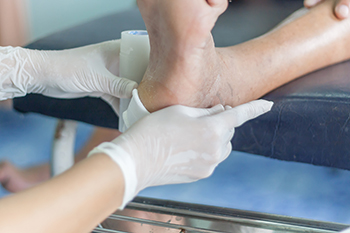
Wounds that develop on the feet can make it difficult to complete everyday activities. A cut or scrape on the foot of a patient who does not have diabetes is easily treated with a bandage for a few days and then removed. The opposite is true with diabetic patients as it can take several weeks for a foot ulcer to heal that began as a cut. Many serious foot wounds require protection against further pressure and patients often wear an “offloading” boot that may accelerate the healing process. Wounds on the feet that do not heal promptly can be the first sign that diabetes may have developed. If the protective boot is worn, it is beneficial that the wound is managed correctly by noticing the amount of ooze and discharge that can affect the skin. Using antiseptics may be suggested as they can help to clean the wound site followed by using special dressings that can reduce the number of bacteria. If you have wounds on your feet, it is strongly advised that you are under the care of a podiatrist who can help you properly treat and manage the condition causing them.
Wound care is an important part in dealing with diabetes. If you have diabetes and a foot wound or would like more information about wound care for diabetics, consult with Dr. Thomas E. Silver from Westwood Foot Clinic. Our doctor will assess your condition and provide you with quality foot and ankle treatment.
What Is Wound Care?
Wound care is the practice of taking proper care of a wound. This can range from the smallest to the largest of wounds. While everyone can benefit from proper wound care, it is much more important for diabetics. Diabetics often suffer from poor blood circulation which causes wounds to heal much slower than they would in a non-diabetic.
What Is the Importance of Wound Care?
While it may not seem apparent with small ulcers on the foot, for diabetics, any size ulcer can become infected. Diabetics often also suffer from neuropathy, or nerve loss. This means they might not even feel when they have an ulcer on their foot. If the wound becomes severely infected, amputation may be necessary. Therefore, it is of the upmost importance to properly care for any and all foot wounds.
How to Care for Wounds
The best way to care for foot wounds is to prevent them. For diabetics, this means daily inspections of the feet for any signs of abnormalities or ulcers. It is also recommended to see a podiatrist several times a year for a foot inspection. If you do have an ulcer, run the wound under water to clear dirt from the wound; then apply antibiotic ointment to the wound and cover with a bandage. Bandages should be changed daily and keeping pressure off the wound is smart. It is advised to see a podiatrist, who can keep an eye on it.
If you have any questions, please feel free to contact our office located in Golden Valley, MN . We offer the newest diagnostic and treatment technologies for all your foot care needs.

